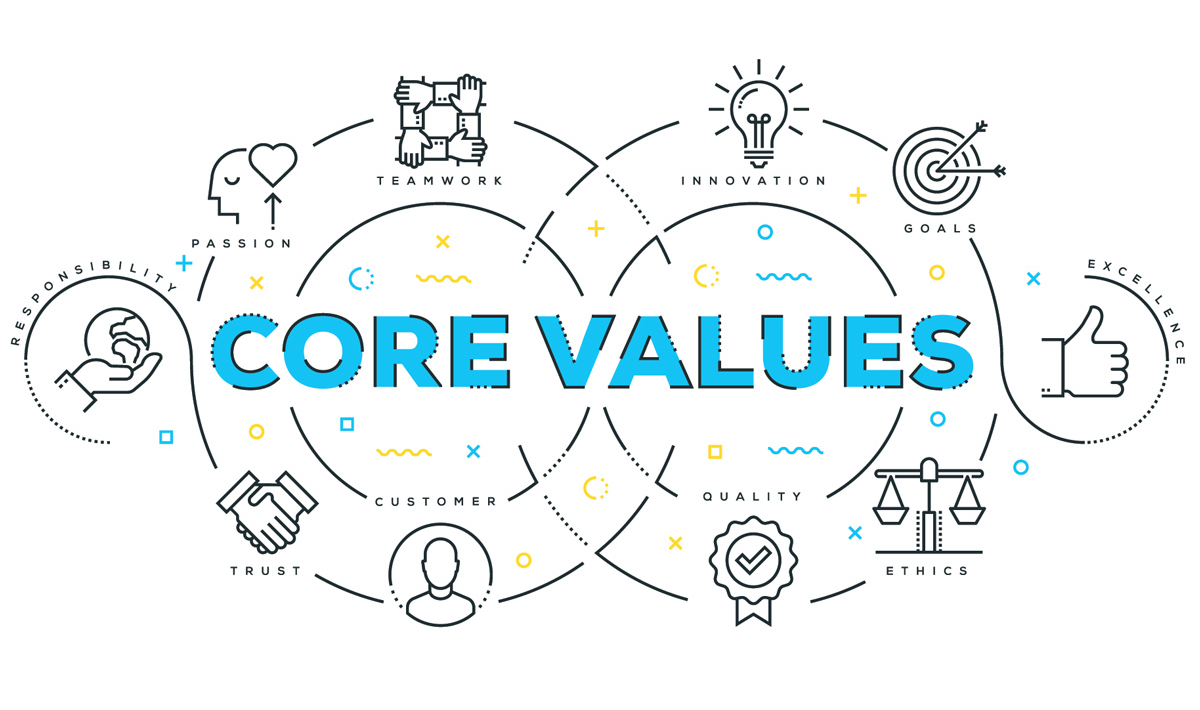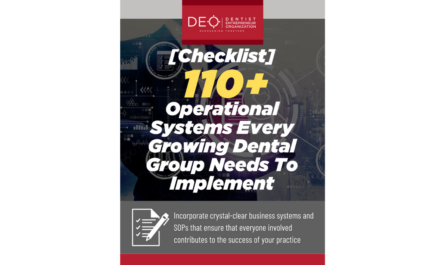Why your core values are an integral part of your operating system and how to bring them to life.
By Josey Sewell, RDH, DEO, Partner
The idea of core values is used all the time in books and talks about business and team dynamics. Most people believe you should have a set of core values, and most companies have attempted to determine their core values and maybe even have them on a poster or painted on the wall. That is often where it stops; a few nice words on the wall with very little action, intent or truly living the core values. This article is a mini-course on how to take your core values from being pretty words on a wall to truly something that can define the identity of your company and team.
Your core values are not for your patients; this is not a way to market to patients and help them believe you should be their dental provider. Core values are for the team. Core values should differentiate “your people” from the general population. Are you familiar with the term “right people in the right seats”? Right people = people that live your core values. They belong in your organization. Right seats = the person is right for the position they are in. You should hire, fire, review, reward, and recognize based on your core values, and I will show you how.
Discover & define
It would be a mistake to sit down as the owner or leader of a company and simply write down some values that sound nice or make a snappy acronym. Core values should already be present within your team. The appropriate exercise is to discover your core values by evaluating and reflecting on your ideal team members. Once you discover your core values, you need to narrow them down. The rule of thumb is 4-6 values; less is more. You want your team to be able to remember them, recite them, and understand them. You can be as creative as you want because these values are for your internal team; they aren’t for your patients. It also doesn’t have to mean anything to anyone outside your team. The core values can be simple words, or they can also be phrases. This is where you have the opportunity to be as creative and fun as you like. Take Ume Dental in Idaho for example; they used superheroes as personas representing certain values they expect their team members to have. They chose Samwise Gamgee from the Lord of the Rings to represent humility and being an enthusiastic supporter of others. CarolinasDentist has a core value called “funergetic” which is a combination of adding an element of fun to everything they do and also doing it with enthusiasm and energy. Energy is contagious and they wanted to hire team members based on their positive energy and willingness not to take themselves too seriously. Don’t turn your core values into corporate speak that team members cannot relate to, make them as unique as your personality. Following the discovery and selection process, you must clearly define them. These definitions should be on one page. A few bullet points or sentences for each value including a possible anti-value to ensure the team knows what you mean by each core value. When your core values are decided and defined, the fun work begins.
Hire
Values are not something that are always apparent or obvious in a job interview, so is it really possible to hire for core values? The answer is yes, absolutely, and we can create a system around it. I’ve worked with hundreds of hiring managers who feel like they hire around core values, but the truth is, they use the core values as a mental model and try to check the values off in theory only. I would encourage you to move from using core values as a mental model to actually building a systemized process around your core values. Here are a few best practices to get you started:
• Use behavioral-based interview questions to write one or two open-ended questions for each of your core values.
• What not to do – “One of our values is humility, are you humble?” Remember, people are professional interviewers and will answer the question based on what you want to hear, and not what reality is.
• What to do instead – “Can you tell me about a time when you made a mistake and how you handled that mistake?” When you give people a scenario or ask them to tell you a story about their life, you are going to learn more about how they actually behave. You should be listening for keywords or phrases that would lead you to believe this person is actually humble. Can they admit when they are wrong, can they own up to mistakes, ask for help or ask for forgiveness? If so, they are probably humble.
• Create a point system for the questions. Simple check for yes and X for no. If you have six core values but only answered two out of six in a way that leads you to believe they have that core value, they may not fit your organization.
• Standardize and train your team and hiring managers to use the same questions and point system and continually come back and work together to refine and improve the questions you ask. This ensures that no matter who is doing the interview or the hiring, we have a consistent process for evaluating based on core values and are not overly dependent on one person to do the hiring.
Fire
A point in time will come, if it hasn’t already, that will test your commitment to your core values. When you are willing to make a tough decision based solely on core values and exit someone who may be good at their job but not a fit for your culture, you will know if the values are real or just a story you tell. When working with people, you will have only a few problems.
• Wrong person, wrong seat. This is actually the easiest scenario. Someone isn’t right for your culture and they aren’t performing well in their job. Exit quickly and kindly.
• Right person, wrong seat. The person is right for your organization (value fit) but they are in the wrong seat. If you have a seat that is better for them, move them to the seat. Be very careful creating new seats that would not normally exist in your organization, because it usually doesn’t end well. You may love this person but have to exit them because the right seat isn’t available.
• Wrong person, right seat. This will test your commitment to your values. You might have someone who is a high performer, maybe even a provider, but they are not a core value fit. You can easily justify that it is too hard to recruit and hire and keep this person, but personal experience across hundreds of practices will tell you – these are culture killers. You get what you tolerate. When you allow high performers who are not value fits to stay in your organization, it deteriorates and eats away at your culture and team. There is a certain level of discipline you must have to live your values.
• The difference between being a core value fit and not being a core value fit must be defined by you. We use the Fit Filter tool to help teams set their standard expectations and outline in a point system to make these emotional decisions much simpler and easier.
Review
Did you know, there is zero research that shows annual performance reviews actually improve performance? Team members want feedback far more frequently than once a year. We recommend a structured quarterly process we call the Quarterly Check-in. The structure we follow is Connect, Measure, Coach. In the measure portion of the process we have team members report on their key performance indicators, self-evaluate their alignment to the company vision, and rate themselves on how well they live the core values. The process also has the manager rate the team member on how well they live the core values and it is discussed on a quarterly basis. This opens up meaningful conversations and direct feedback on a timely basis so theteam members know exactly where they stand. This also makes it really easy for team members to self-identify and self-select out if they don’t fit the values. This makes managing teams so simple and so much easier.
Recognize & reward
When we use core values only to review or fire team members, they become a weapon and a punishment. You will have greater adoption, engagement, and even ownership of core values from your team when you do a great job recognizing and rewarding around them. When we moved to intentionally and systematically recognizing and rewarding our team, our values came to life. So much so that I remember one day a dental assistant called our dentist owner and said, “Dr. Roman, you hired this dentist and dropped him in my office, but he is not relationship-based, and he isn’t humbly confident. You need to get down here and fix it or let him go.” Imagine the conviction it takes for a dental assistant to call the owner and point out that a dentist wasn’t a fit! It was an environment of true mutual accountability for the standards and behaviors we expected, and it was a team effort and not a burden placed solely on the leadership team. Here are some fun ideas how to recognize and reward based on core values:
• Core Value call outs. Weekly we had Team Messaging that went out to the whole company from our Visionary. Inside that communication were five to six core value call outs and the team was excited to read it weekly to see if they made the shout-outs. We would include the person’s name, their actions, and how they connected to a specific core value. You have to be intentional about connecting behaviors to certain core values so the team sees how the values are being lived.
• Punch cards. Each team member had a Core Value punch card. It was a business card with our logo on the front, our values on the back and two “punches” for each core value. Our managers had a special hole punch. When they caught the team living core values, they would give them a “punch”. When the team member got all the punches, they would get a special fleece jacket with our logo and their name embroidered on it. We kept this SWAG a specific color so that it was easily recognized as a core value award and meant a great deal to our team members. They would start over with a new punch card and when that was filled up we had a SWAG store and let them pick what they wanted.
• Annual awards. If you have an annual party you can include a nicer award each year for your core values. This might come with money or nicer awards that someone can keep and display. I strongly recommend this type of award be a peer-nominated award and not chosen by the leadership team alone. There are team members that know how to put on a good face when the boss is present but are awful to work with for peers. This ensures you aren’t awarding the people who work hard to just get your attention, but award those that day in and day out are living your values. There is also something incredibly special about being recognized by your peers, and from my experience usually leads to happy tears.
Gallup research shows that the greatest economic disparity in the world is the inability to unlock human energy. If we could unlock that energy and had team members that were truly engaged and aligned with the business’s goals, the world would change overnight. Having meaningful core values that are alive and well in your organization and not just pretty words on a wall is a great first step to unlocking that human energy and aligning that energy with results.
When done well, living core values through hiring, firing, reviewing, rewarding, and recognizing will make your team and company stronger, more resilient, and subsequently more profitable. You will know the values are alive and working when you start to see those who are not a fit start to self-select out and that is an incredible gift to you and the business. I hope this article has given you some fresh perspective and ideas on how to bring your core values to life. If you want help discovering, defining and bringing your core values to life, consider joining our Implementation program where we work with you and your leadership team to define the values and create the systems to bring them to life.





